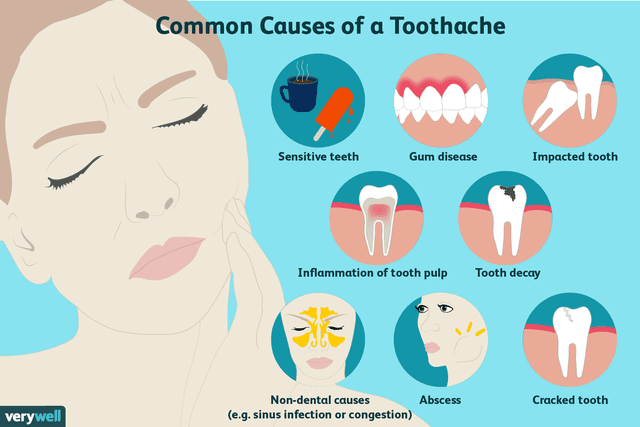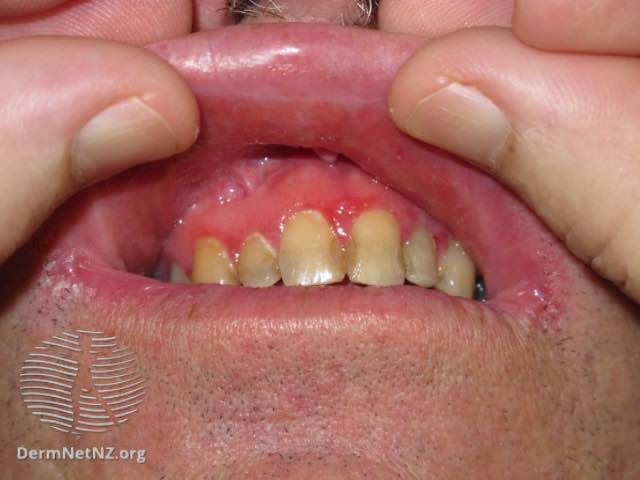Tooth Pain: Causes, Treatment, and When to See a Dentist
An Overview of Tooth Pain

Medically reviewed by Brian T. Luong, DMD
Tooth pain may occur because of tooth sensitivity, a mouth injury, decay, an infection, or other issues. You might feel a sharp pain or a persistent ache. It can cause problems when eating, disrupt your sleep, or bother you throughout the day.
How bad your tooth pain isn't necessarily a reflection of the severity of the problem, either. A toothache can be significant even if it is caused by a relatively minor problem. That can make it hard to tell when tooth pain is serious, and you need to get to the dentist.
This article explores the possible causes of tooth pain and the signs you need to get checked out. It also covers how tooth pain is diagnosed and treated, and how it can be prevented.

Verywell / Alexandra Gordon
What Causes Tooth Pain?
Common causes of a toothache that relate to your oral health include:
Gum disease
Tooth decay
Bruxism (grinding teeth while awake and/or asleep)
A cracked tooth due to mouth trauma
A tooth abscess (infection in the center of the tooth)
An impacted tooth (a tooth that doesn't fully break through the gums)
Tooth pulp inflammation (called pulpitis), which causes pain in the center of the tooth
Less often, Ludwig's angina, a serious but rare mouth infection, can cause tooth pain.
Related:How Toothaches and Headaches Are Related
Gum Disease
Gum disease, or periodontitis, is characterized by an infection of the gums.
More specifically, with gingivitis, which is the early stage of gum disease, the gums become inflamed and hot, red, and swollen.
Both gingivitis and periodontitis can cause mild or intense pain. Typically, the worse the pain, the more advanced the infection is.

DermNet / CC BY-NC-ND
Tooth Decay
Tooth decay, also called dental caries, refers to the gradual destruction and cavity formation in the outer surface, or enamel, of the tooth.
Plaque, a sticky layer of bacteria that forms on the tooth enamel, feeds on the sugars and starches from food particles in your mouth. This produces an acid that eats away at the enamel, causing weak areas and holes. Over time, the enamel breaks down, and a cavity forms.
As the decay spreads inward toward the middle layer of the tooth, known as the dentin, it can cause pain and sensitivity.
Sensitive Teeth
Teeth sensitivity develops from exposed dentin. This can happen as a result of cavities, worn fillings, receding gums, or cracked teeth.
Teeth sensitivity is associated with quick, sharp pain when exposed to a triggering situation, such as teeth brushing or cold air exposure.
Bruxism
Bruxism, which is characterized by clenching and teeth grinding, can occur while sleeping or while awake.
Over time, it may cause:
Tooth sensitivity
Cracked teeth
Tooth or facial pain
Temporomandibular joint disorder (TMJ)
Cracked Tooth
A cracked tooth may be caused by trauma to the mouth, severe teeth grinding, or biting down on something hard.
Symptoms of a cracked tooth may include a sharp pain when biting or chewing, as well as temperature and food sensitivity.
The five types of cracks in teeth include:
Craze lines: Shallow, tiny cracks on the outer enamel
Fractured cusp: A piece of the tooth's chewing surface breaks off, usually around a filling
Cracked tooth: A crack goes from the chewing surface of your tooth to the root of the tooth
Split tooth: The tooth splits into two parts
Vertical root fracture: A crack forms in the root of the tooth and may go unnoticed until an infection develops
Abscess
A dental abscess, which may result from an untreated cavity or pulpitis, is caused by the buildup of bacteria inside the pulp chamber. A tooth abscess typically presents with an infection that has spread from the tooth to the surrounding area.
The infected pulp chamber tries to drain itself out of the very tip of the tooth root, which is located beneath the pulp. This can cause intense pain and swelling.

DermNet / CC BY-NC-ND
Impacted Tooth
Teeth can become impacted when something stops them from moving into their proper position in the mouth.
Wisdom teeth commonly get impacted because they are usually the last to break through, and you may not have room for them in your mouth.
Impaction can cause:
Pressure
Pain
Swelling
If impacted wisdom teeth become infected, it can cause sharp pain, fever, gum inflammation, and trouble swallowing.
Related:Wisdom Teeth Removal
Inflammation of the Tooth Pulp
Pulpitis is a condition that occurs when the tissue in the center of the tooth, also known as the pulp, becomes inflamed and irritated. This can lead to pain and an intense sensitivity to various things, such as temperature.
Conditions that may trigger pulpitis include:
Tooth decay
Trauma to a tooth
Multiple procedures done on a tooth
Pulpitis may or may not be reversible. If it is, the pain or sensitivity stops within a couple seconds after the trigger is removed. If pulpitis is irreversible, the pain can linger for minutes after the trigger is taken away. Irreversible pulpitis can also present with spontaneous pain that may not require a trigger.
Ludwig's Angina
Ludwig's angina (also called submandibular space infection) is a rare bacterial infection under the tongue. It can be life-threatening and requires emergency treatment.
Ludwig's angina can be caused by mouth trauma or a tooth abscess.
This condition may cause:
New or increased tooth pain
Fever
A swollen tongue that may stick out of your mouth
Difficulty swallowing or speaking
Drooling
Neck pain, swelling, and redness
Weakness and fatigue
Confusion
Earache
This infection is very serious and can spread fast. If it gets into your airway, it can make breathing difficult. It can also lead to bodywide infection (sepsis) and septic shock. Call 911 or get to an emergency room right away if you notice changes in breathing.
How Is Tooth Pain Diagnosed?
To determine the cause of your tooth pain, your dentist may take a medical history, give you a physical exam, and have you undergo an imaging test, such as an X-ray.
Medical History
Your dentist will ask you questions about your symptoms, including:
Where it hurts
What makes it better or worse
How long you've had pain
If you have other symptoms, such as swelling or fever
Physical Examination
Your dentist will likely check your mouth and face for swelling. During the oral (mouth) exam, they'll look for inflammation and signs of an infection.
A physical exam includes:
Intraoral exam inside the mouth: Can detect swelling, a decayed or broken tooth, and soft tissue and hard tissue lesions
Extraoral exam outside the mouth: Can detect swelling, evaluate pain distribution, TMJ jaw movements, joint sounds, and myofascial pain
For potentially worrisome symptoms, like a fever or neck pain, your dentist may perform a cranial nerve exam, which focuses on the head.
Learn More:Understanding the Dental Exam
Imaging and Other Tests
Your dentist may want to take a dental X-ray to check for abscesses, cavities, or any other problems.
A computed tomography (CT) scan or magnetic resonance imaging (MRI) test may be more helpful for diagnosing rare conditions like Ludwig's angina.
Other tests may include:
Vitality testing (cold or electrical pulp test)
Bite test for a cracked tooth
ENT Evaluation
Sometimes, tooth pain or sensitivity has nothing to do with your teeth. Other conditions that can cause a toothache include:
A sinus infection, which can radiate pain through to your mouth or make your teeth feel sensitive
TMJ (dysfunction of the jaw joint), which may cause pain or tenderness that worsens with jaw movement and chewing
You may be referred to an ear, nose, and throat specialist (ENT) for an evaluation if your dentist suspects that your tooth pain is unrelated to your oral health.
How Is Tooth Pain Treated?
Treatments for tooth pain depend on the underlying cause.
They may include:
Medication
Oral rinses
Oral devices
Most conditions that cause tooth pain can get worse or cause additional problems if they're not taken care of early on. It's always best to get checked and start treatment as soon as possible.
Medication
Your dentist may recommend or prescribe various medications:
Pain relief: Tylenol (acetaminophen) or a nonsteroidal anti-inflammatory (NSAID) such as Advil (ibuprofen) or Aleve (naproxen)
Antibiotics (for abscess, pulpitis, or other infections): Amoxicillin, clindamycin
Oral Rinses and Topical Fluoride
Oral rinses include:
Chlorhexidine: Reduces mouth bacteria; may be used to treat gingivitis
Fluoride rinses: Can help prevent or treat tooth decay and gum disease
For sensitivity and pain, your dentist may apply fluoride to your teeth and recommend a fluoride toothpaste designed for sensitive teeth.
Oral Devices
If you have sleep-related bruxism, your dentist may recommend wearing an oral device, like a mouth guard, at night. Over-the-counter options that mold to your teeth are the most affordable, but custom guards made from molds of your teeth are typically more comfortable and durable.
While a mouth guard will protect your teeth from damage, it won't decrease the number of bruxism episodes. With this in mind, you may want to also work to address your underlying bruxism triggers, which can include stress, anxiety, and anger.
Dental Procedures
For certain conditions, you may need one of several dental procedures.
Tooth decay and cavities: Drilling to remove the decay and replacing lost materials with a filling
Irreversible pulpitis: A root canal to remove the infected pulp, and will almost always require a crown
Abscess: The infected pocket is cut open and drained
Cracked tooth: A filling, a root canal, or removal and replacement, depending on the extent of the damage
At-Home Relief
It can sometimes take a few days or more to get a dentist appointment. At-home remedies to try while you wait to be seen include:
Clove oil: Dilute a few drops of clove oil in olive oil, apply to a cotton ball, and place it on the gums near your toothache for 5 to 10 minutes. Clove oil contains eugenol, a natural anesthetic with anti-inflammatory properties.
Ice: Apply an ice pack or bag of frozen vegetables wrapped in a clean towel to the outside jaw for about 20 minutes. Repeat as needed throughout the day.
Rinse: Swish warm salt water (1/2 teaspoon salt in 8 ounces of water) or diluted hydrogen peroxide (1:1 ratio) for about 30 seconds, then spit out.
OTC pain relievers: Tylenol (acetaminophen), Advil (ibuprofen), or Aleve (naproxen) can be taken according to package instructions.
How Do I Prevent Tooth Pain?
To prevent cavities, gum disease, and tooth sensitivity, practice good oral hygiene:
Brush your teeth gently twice a day.
Use a fluoride toothpaste.
Floss daily.
Drink fluoridated water when possible.
Get your teeth cleaned regularly.
Don't smoke.
Avoid habits like chewing pencils or biting down on a fork.
When to See a Dentist for Tooth Pain
Make an appointment with your dentist if:
Your tooth pain is intense.
You have a fever.
You have a broken, cracked, loose, or knocked-out adult tooth.
You have a cavity or hole in your tooth.
Your face and/or mouth are swollen.
Your toothache won't go away.
A toothache may warrant a trip to the emergency room. Symptoms that should be seen right away include:
Bleeding that doesn’t stop with applied pressure
A fever above 101 degrees F
A knot or lump on your jaw
Swelling under your eye
Severe tooth pain that doesn't improve with medication
Summary
Tooth pain may be caused by an infection or disease, mouth trauma, general sensitivity, or inflammation. Call your dentist if you have intense tooth pain, a fever, or swelling in the face or mouth.
Tooth pain treatment varies with the cause. Whether you need medication, an oral device, or something else, the sooner you're treated, the better.
